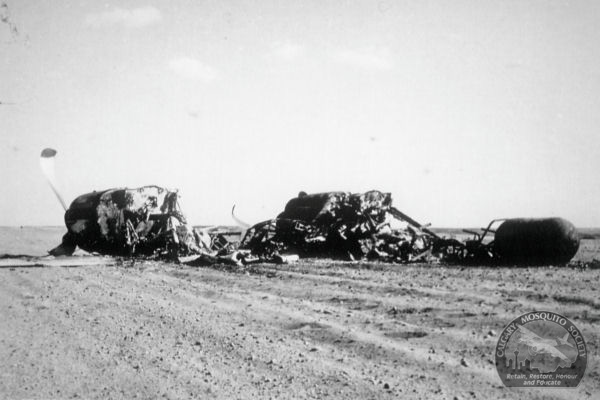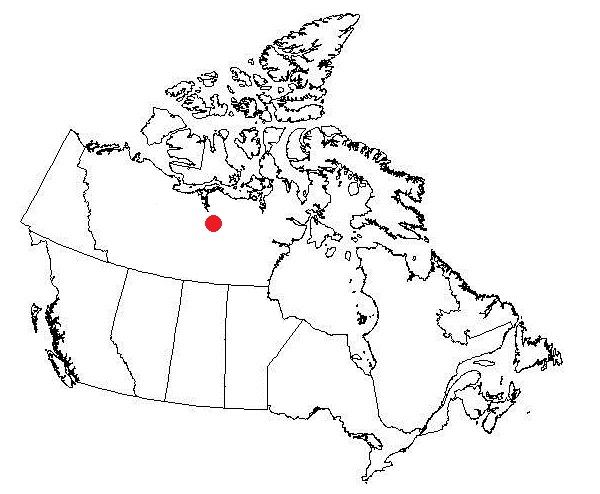

Thanks to our friends at the Ventura Memorial Flight Association the Calgary Mosquito Society has acquired an important and unique
piece of equipment for our survey Mosquito restoration. Looking like a giant silver cocktail sausage, this steel cylinder once held oxygen for the crew in another of Spartan Air Services'
Mosquitoes, and came to us under amazing circumstances.
On the morning of July 19, 1956, pilot Al MacNutt, navigator Vince Kluke and camera operator Barry Cox were on a flight some 300 miles west of Pelly Lake, Northwest Territories. Just before
9:00am, as they cruised along at 30,000 feet, a small fluctuation in the oil pressure led MacNutt to shut down the port engine. Within minutes the propeller had moved out of feather and was
screaming at 5,000rpm - so fast the spinner flung off. At that speed the friction inside the engine became so great that temperatures skyrocketed and parts began breaking. Pistons,
connecting rods, flames and smoke streamed from the port engine when MacNutt ordered Cox to abandon his post in the rear fuselage. If CF-HMR crashed he'd be trapped inside as his entry door
was on the fuselage's underside.
Shortly afterwards, Kluke also opted to take to his parachute. Even MacNutt wanted to leave, but because of the torque caused by the runaway propeller, every time he let go of the controls
CF-HMR tried rolling over on its back.
MacNutt eventually man-handled the Mosquito back to Pelly Lake, where he managed to bring her down to a belly landing. Stopping quickly in the soft sand, he quickly climbed out the overhead
emergency exit and ran to safety, waiting for the plane to explode.
For MacNutt and Spartan Air Services Ltd., that was the end of CF-HMR. Within 20 minutes she'd been consumed by fire and a bulldozer pushed the smoldering remains off to the side of the
airstrip.
When Pelly Lake was finally abandoned as a base for survey flights no one thought to collect the remains of CF-HMR or the hundreds of 45-gallon fuel drums brought north to permit flying in
the barrens. Eventually however, as the decades passed, people became aware of the risk to the environment all those rusting fuel drums presented; many still contained gallons of aviation
gasoline.
In July 1996, members of the Windsor Bomber Group and the Ventura Memorial Flight Association spent 18 days in Pelly Lake, salvaging parts of CF-HMR and assisting in removing more than 400
fuel drums as part of a larger government program to cleanup sites across the North. While the Windsor Bomber Group was after Mosquito pieces, the Ventura Memorial Flight Association was
able to salvage an R-2800 engine that had also been abandoned in the 1950s.

July 1956, after fighting to keep his crippled Mosquito under control, Al MacNutt managed to bring CF-HMR down to a belly landing at Pelly Lake. After being consumed by fire the Mosquito's remains were bulldozed off the side of the runway. The crew oxygen tank is clearly visible to the right of the photo. (A. MacNutt)

Pelly Lake is quiet literally in the middle of nowhere - roughly 500 miles north of the Manitoba-Saskatchewan border. Because of its remote location, if an item wasn't worth more than the transportation costs, they were simply abandoned. (CMS)

Trevor McTavish (left) and Scott McTavish (right) accept the donation of CF-HMR's oxygen bottle from the Ventura Memorial Flight Association on June 2, 2012. The tank measures 48 x 24 inches and weighs at least 80 pounds. Despite 40 years in the open at Pelly Lake and 16 more years in storage in Edmonton, the tank is in remarkably good condition. (A. Yeats)